|
|
|
Friday, October 24th 2008 [ versión español ]
One of the University of Puerto Rico at Mayagüez (UPRM) classrooms recently converted into a laboratory of artistic improvisation, appointed by Maestro Antonio Martorell as the Puerto Rican Institute of Happy Accidents, (IPAF, by its Spanish acronym) which spread the word about the sublime talents of UPRM engineers, composers, and artists.
How does verbal expression interact with that of the plastic arts? How does music translate to words, or to art? These were just a few of the ideas explored in the workshop, Lengua, sonido e imagen (Language, Sound and Image) that historian Gervasio García and artists Antonio Martorell and José Antonio López offered the weekend of October 10, 11, & 12.
At the workshop, Martorell and López played with improvisation and the artistic fluidity between visual, verbal, and auditory elements. The workshop was an event sponsored by the Cultural Agenda, coordinated by the Committee of Cultural Promotion, of the Humanities Department.
Doctor Laura Bravo, committee member and Humanities professor, explained that the idea for the workshop came about during a speech that Martorell gave to the UPRM community this past March 27th, in front of the Serpentinata Caribeña.
“After hearing the guitar chords played by José Antonio López, the artist commented how in his mind he was simultaneously expressing these sounds with moving images. Suddenly, he threw out the idea to give a workshop where music, literature, and the visual arts would be created simultaneously and communally. His idea was received with great excitement, and was able to come to life a few months later; with such an amazing reception, the dates for the workshop were quickly presented.”
The workshop, which was valued at 15 contact hours, had an enrollment of around 50 participants; among these were students, professors, employees, and people from the community, who met in a packed room 121 of the UPRM Chardón building.
“We are filled with satisfaction that an icon of the Puerto Rican Arts, who is internationally famous as well, has the desire to invent and create at our campus; to want to return to work with our students and to feel as if this were his home. And, not only that but to bring figures such as Gervasio García, one of the most well-known Puerto Rican historians, is something to thank him for,” said Bravo.
Friday evening, the painter, engraver, writer, and educator, Martorell read his speech entitled, El Velorio: velo, desvelo y revelo de la lengua (The Wake: vigilence, awakening, and revealing of the language) the same one he read when he was inducted into the Puerto Rican Academy of the Spanish Language. This speech was followed by the reading of Contestación de un desvelado por El Velorio de Martorell, (Response to the awakening by The Wake of Martorell) by academic and historian, doctor Gervasio García.
Saturday and Sunday the workshop consisted of a cyclic interaction between word, guitar melody, drawing, and painting by the verb, and finally, language transformed into sound and image. In this part of the workshop maestro Martorell united his art to the music of guitarist José Antonio López, who is an associate professor of the Humanities Department at UPRM.
That is how the song by Paraguayan composer Agustín Barrios, Una limosna por el amor de Dios, (Alms for God’s love) interpreted by doctor López on his guitar, transformed into the poem entitled, El círculo (The Circle). The song inspired doctor Camille Cruz, professor in the Hispanic Studies Department, whose verses read as following:
“Se agita temblorosamente hacia la muerte en la paleta de papel, por qué, Oh Dios! Siento que me ahoga… No quiero mirarla; parece de sábila, amarilla, como el musgo de las aceras olvidadas. Vegetación muerta me abraza, me dice al oído avanza…”
(She shakes trembling unto death in the paper palette, why, Oh God! I feel as if I’m drowning…I don’t want to look at her; she looks like aloe, yellow, like moss of forgotten sidewalks. Dead vegetation engulfs me, it whispers in my ear hurry up…)
Likewise, Martorell painted images with words from his writing, La mano que sueña, whose fragments were read by Martorell as well as doctor Lydia Margarita González Quevedo, also from the Humanities Department.
“La pluma escarba la página en blanco hasta encontrar el hilo negro que tejerá el relato. El ojo descubre el objeto de una mirada que ve ahora de un modo distinto porque lo ve con la mano que desenrolla el hilo, apunta y da puntadas siguiendo la forma y persiguiendo el sentido,” (The pen scratched the blank page until it encountered the black thread that weaved the story. The eye discovered the object in one glance which it now sees differently because it sees it as the hand that unravels the thread, aim and stitch following the pattern and pursuing the meaning) articulated González Quevedo, who also read Los Salmos by Ernesto Cardenal.
El Cádaver exquisito-surrealist technique by which collectively assembles a set of words and images- was the workshop’s main exercise because it integrated visual, auditory, and verbal aspects. It encompassed the basic idea of the drawing enchanted with the ability to translate itself into writing.
“Drawing has a bewitching aspect, to submit to an order where one appears to be in charge but in reality is a servant to a digital passion,” commented Martorell.
As a result of the workshop, the participants hope to put together an exhibit with the works that were created during the artistic collaboration, some of which will probably remain permanently to be appreciated in one of the UPRM classrooms. As it was explained by Bravo, Martorell, created this challenge with the purpose of sharing with the rest of the community the literary and visual works, and surrealist cadáveres exquisitos that were created by all the participants and the video tape that recorded each session.
“It’s very impacting, the empathy that Toño Martorell has for the students of UPRM. The act of seeing how different generations are able to communicate, understand, and feed off of each other, so willingly, but above all, are able to teach and learn about the mystery and magic of creation together,” stated Bravo.
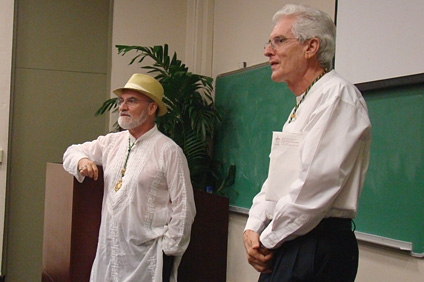
From left to right, artist Antonio Martorell with doctor Gervasio García who read their respective writings as part of the induction ceremony for Martorell into the Puerto Rican Academy of the Spanish Language. (Photograph by Lydia M. González Quevedo)
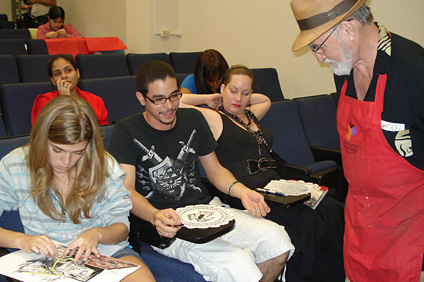
Maestro Martorell observes the artistic work in progress from various workshop participants.
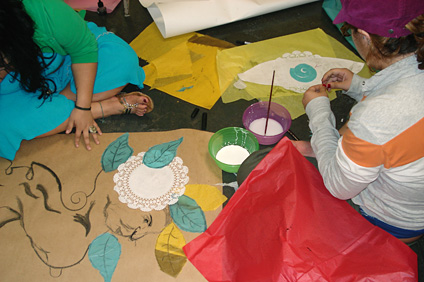
The workshop consisted of a cyclic interaction between word, guitar melody, drawing, and painting by the verb.
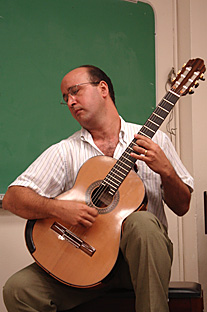 |
|
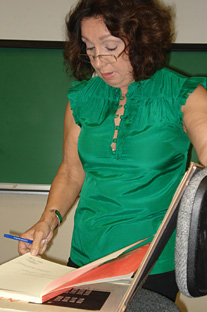 |
| Artists and writers explored the creative activity with music interpreted by guitarist José Antonio López, associated professor of Humanities. |
|
Doctor Lydia M. González Quevedo read fragments of La mano que sueña by Martorell, and Los Salmos by Ernesto Cardenal. |
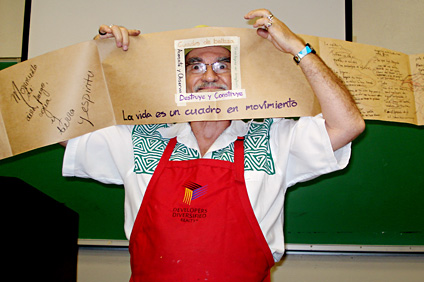
Martorell was part of an exercise at the workshop, Cadáver exquisito, which integrated visual, auditory, and verbal aspects.
Photographs by Alessandra Otero Ramos / UPRM Press
|

